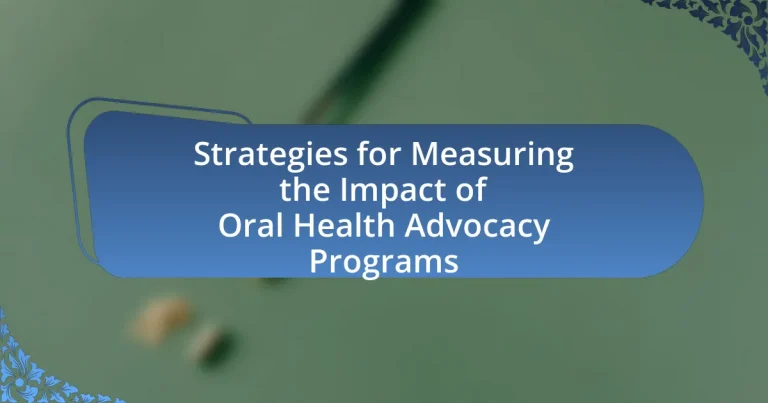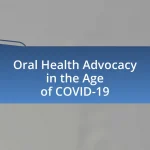The article focuses on strategies for measuring the impact of oral health advocacy programs, emphasizing the importance of both quantitative and qualitative methods. Key strategies include the use of surveys to assess changes in knowledge and behaviors, qualitative interviews to gather personal insights, and health outcome metrics to evaluate public health improvements. The article also discusses defining success through measurable outcomes, establishing baseline data for comparison, and the role of stakeholder perspectives in impact measurement. Additionally, it addresses challenges in evaluation, biases that may affect results, and best practices for reporting and utilizing findings to enhance program effectiveness.
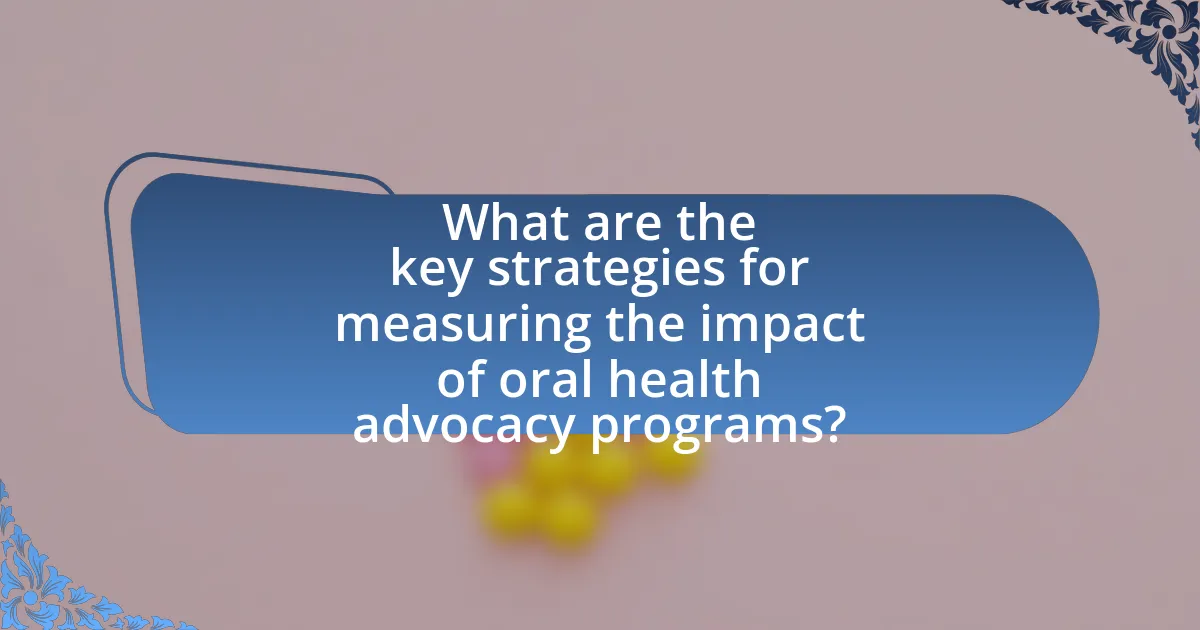
What are the key strategies for measuring the impact of oral health advocacy programs?
Key strategies for measuring the impact of oral health advocacy programs include the use of quantitative surveys, qualitative interviews, and health outcome metrics. Quantitative surveys can assess changes in knowledge, attitudes, and behaviors related to oral health among target populations, providing measurable data on program effectiveness. Qualitative interviews offer insights into personal experiences and perceptions, helping to understand the program’s influence on community attitudes. Health outcome metrics, such as changes in dental visit rates or reductions in oral disease prevalence, provide concrete evidence of the program’s impact on public health. These strategies collectively enable a comprehensive evaluation of advocacy efforts, ensuring that the effectiveness of oral health initiatives is accurately assessed and improved over time.
How can we define the success of oral health advocacy programs?
The success of oral health advocacy programs can be defined by measurable improvements in oral health outcomes, increased public awareness, and enhanced access to dental care services. These programs are considered successful when they lead to a reduction in oral diseases, such as cavities and periodontal disease, as evidenced by statistical data from health surveys. For instance, a study published in the Journal of Public Health Dentistry indicated that communities with active oral health advocacy initiatives saw a 20% decrease in dental caries among children over a five-year period. Additionally, success can be gauged by the level of community engagement and participation in oral health education programs, which can be tracked through attendance records and surveys measuring knowledge gain.
What metrics are commonly used to evaluate program effectiveness?
Common metrics used to evaluate program effectiveness include outcome measures, process measures, and impact measures. Outcome measures assess the changes in health status or behavior resulting from the program, such as the reduction in dental caries rates or increased access to dental care. Process measures evaluate the implementation of the program, including participant engagement levels and adherence to program protocols. Impact measures focus on the broader effects of the program on community health, such as improvements in overall oral health literacy or changes in public policy related to oral health. These metrics provide a comprehensive framework for assessing the effectiveness of oral health advocacy programs.
How do we establish baseline data for comparison?
To establish baseline data for comparison, collect quantitative and qualitative information on key metrics before implementing an oral health advocacy program. This involves conducting surveys, interviews, and assessments to gauge the current state of oral health within the target population. For instance, a study by the American Dental Association found that baseline surveys can reveal existing knowledge gaps and behaviors related to oral health, which are essential for measuring program impact over time. By documenting these initial conditions, stakeholders can effectively compare future outcomes against this established baseline, ensuring that any changes can be attributed to the advocacy efforts.
What role do stakeholder perspectives play in measuring impact?
Stakeholder perspectives are crucial in measuring impact as they provide diverse insights that shape the evaluation process. Engaging stakeholders, such as patients, healthcare providers, and community members, ensures that the metrics used reflect the values and priorities of those affected by oral health advocacy programs. For instance, a study published in the Journal of Public Health Management and Practice highlights that incorporating stakeholder feedback leads to more relevant and effective impact assessments, ultimately enhancing program outcomes. This alignment with stakeholder views not only improves the accuracy of impact measurement but also fosters greater community trust and support for advocacy initiatives.
How can we gather feedback from participants and community members?
To gather feedback from participants and community members, implement surveys and focus groups. Surveys can be distributed online or in person, allowing participants to provide quantitative and qualitative feedback on their experiences and perceptions of the oral health advocacy programs. Focus groups facilitate in-depth discussions, enabling community members to express their thoughts and suggestions in a collaborative environment. Research indicates that utilizing both methods increases response rates and provides comprehensive insights, as evidenced by a study published in the Journal of Community Health, which found that mixed-method approaches yield richer data for program evaluation.
What methods can be used to assess stakeholder satisfaction?
Surveys and interviews are effective methods to assess stakeholder satisfaction. Surveys can quantitatively measure satisfaction levels through structured questions, while interviews provide qualitative insights into stakeholder experiences and perceptions. Research indicates that using a combination of both methods yields a comprehensive understanding of stakeholder satisfaction, as surveys can capture broad trends and interviews can explore specific concerns in depth. For instance, a study published in the Journal of Public Health Management and Practice found that stakeholder feedback collected through these methods significantly improved program outcomes in health initiatives.
What are the challenges in measuring the impact of these programs?
Measuring the impact of oral health advocacy programs presents several challenges, primarily due to the complexity of health outcomes and the variability in program implementation. One significant challenge is the difficulty in establishing clear, quantifiable metrics for success, as health improvements can be influenced by numerous external factors such as socioeconomic status, access to care, and individual behaviors. Additionally, the lack of standardized evaluation frameworks across different programs complicates comparisons and assessments of effectiveness. Research indicates that many programs rely on self-reported data, which can introduce bias and inaccuracies in measuring true impact. Furthermore, longitudinal studies are often required to capture the sustained effects of advocacy efforts, yet these can be resource-intensive and logistically challenging to conduct.
How do we address data collection limitations?
To address data collection limitations, researchers can implement mixed-method approaches that combine quantitative and qualitative data. This strategy enhances the robustness of findings by capturing a comprehensive view of the subject matter. For instance, using surveys alongside focus groups allows for the triangulation of data, which can reveal insights that purely quantitative methods may overlook. A study published in the Journal of Public Health found that integrating qualitative interviews with quantitative surveys improved the understanding of community health needs, demonstrating the effectiveness of this approach in overcoming data collection challenges.
What biases might affect the evaluation process?
Biases that might affect the evaluation process include confirmation bias, selection bias, and response bias. Confirmation bias occurs when evaluators favor information that confirms their pre-existing beliefs or hypotheses, potentially skewing results. Selection bias arises when the sample chosen for evaluation is not representative of the broader population, leading to inaccurate conclusions. Response bias happens when participants provide inaccurate or misleading responses, often influenced by social desirability or misunderstanding of questions. These biases can significantly distort the findings of evaluations in oral health advocacy programs, impacting the validity and reliability of the results.
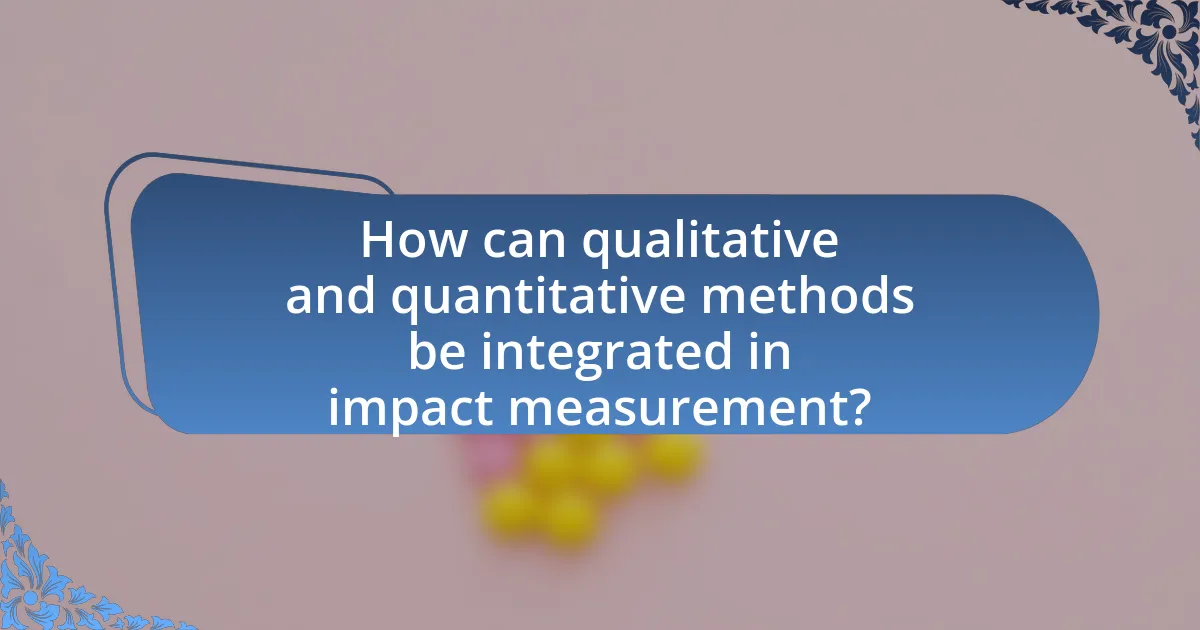
How can qualitative and quantitative methods be integrated in impact measurement?
Qualitative and quantitative methods can be integrated in impact measurement by employing a mixed-methods approach that combines numerical data with narrative insights. This integration allows for a comprehensive understanding of the impact of oral health advocacy programs, as quantitative data can provide measurable outcomes, such as changes in oral health statistics, while qualitative data can offer context and depth through participant experiences and perceptions. For instance, a study might use surveys to gather quantitative data on the prevalence of dental issues before and after an advocacy program, while also conducting interviews to capture personal stories that illustrate the program’s effects on community attitudes towards oral health. This dual approach enhances the validity of findings by triangulating data sources, thereby providing a richer, more nuanced picture of the program’s impact.
What are the advantages of using qualitative methods?
Qualitative methods offer several advantages, particularly in understanding complex social phenomena. They provide in-depth insights into participants’ experiences, beliefs, and motivations, which are often missed by quantitative approaches. For instance, qualitative research can reveal nuanced perspectives on oral health behaviors and attitudes, allowing for a richer understanding of the factors influencing these behaviors. Additionally, qualitative methods facilitate the exploration of context-specific issues, enabling researchers to capture the unique cultural and social dynamics that affect oral health advocacy. This depth of understanding can inform more effective strategies for program implementation and evaluation, ultimately leading to improved health outcomes.
How can interviews and focus groups enhance understanding of program impact?
Interviews and focus groups enhance understanding of program impact by providing qualitative insights that quantitative data cannot capture. These methods allow participants to share personal experiences and perceptions related to the program, revealing nuanced effects on behavior and attitudes. For instance, a study by Krueger and Casey (2015) highlights that focus groups can uncover themes and patterns in participant feedback, which can inform program adjustments and improvements. Additionally, interviews can delve deeper into individual stories, offering context that enriches the overall evaluation of the program’s effectiveness. This qualitative data complements quantitative metrics, leading to a more comprehensive assessment of program impact.
What role does narrative storytelling play in advocacy evaluation?
Narrative storytelling plays a crucial role in advocacy evaluation by providing qualitative insights that quantitative data often cannot capture. This method allows advocates to convey personal experiences and emotional connections related to oral health issues, making the data more relatable and impactful. For instance, storytelling can illustrate the real-life consequences of policy changes or health interventions, thereby highlighting the effectiveness of advocacy efforts. Research indicates that narratives can enhance understanding and retention of information, making them a powerful tool in communicating the outcomes of advocacy programs.
What are the benefits of quantitative measurement techniques?
Quantitative measurement techniques provide objective data that can be statistically analyzed to assess the effectiveness of oral health advocacy programs. These techniques enable researchers to quantify variables such as program reach, participant satisfaction, and health outcomes, allowing for clear comparisons and evaluations. For instance, a study published in the Journal of Public Health Dentistry demonstrated that quantitative surveys effectively measured changes in oral health knowledge among participants, providing concrete evidence of program impact. This data-driven approach enhances the credibility of findings and supports evidence-based decision-making in public health initiatives.
How can surveys and statistical analysis provide insights into program effectiveness?
Surveys and statistical analysis provide insights into program effectiveness by systematically collecting and evaluating data on participant experiences and outcomes. Surveys can capture quantitative metrics, such as changes in knowledge or behavior related to oral health, while statistical analysis allows for the identification of trends, correlations, and causal relationships. For instance, a study published in the Journal of Public Health Dentistry demonstrated that a survey assessing knowledge before and after an oral health program revealed a 40% increase in participants’ understanding of dental hygiene practices, validating the program’s effectiveness through statistical significance. This combination of data collection and analysis enables program evaluators to make informed decisions about program improvements and resource allocation.
What tools are available for data analysis in oral health advocacy?
Data analysis in oral health advocacy can be effectively conducted using tools such as statistical software (e.g., SPSS, R, and SAS), data visualization platforms (e.g., Tableau and Power BI), and survey analysis tools (e.g., Qualtrics and SurveyMonkey). These tools enable researchers and advocates to analyze large datasets, visualize trends, and interpret survey results, which are essential for measuring the impact of oral health advocacy programs. For instance, SPSS is widely used for its robust statistical capabilities, while Tableau allows for interactive data visualization, making complex data more accessible for stakeholders.
How can mixed-methods approaches improve overall evaluation?
Mixed-methods approaches can improve overall evaluation by integrating quantitative and qualitative data, providing a comprehensive understanding of program effectiveness. This combination allows evaluators to quantify outcomes while also capturing the nuanced experiences and perceptions of participants, which can reveal underlying factors influencing those outcomes. For instance, a study by Creswell and Plano Clark (2011) highlights that mixed-methods evaluations can enhance the validity of findings by triangulating data sources, thus offering a richer context for interpreting results. This approach not only strengthens the evidence base but also facilitates more informed decision-making in oral health advocacy programs.
What are the best practices for combining qualitative and quantitative data?
The best practices for combining qualitative and quantitative data include triangulation, integration of findings, and contextualization. Triangulation involves using multiple data sources to validate results, enhancing reliability and depth. Integration of findings requires synthesizing qualitative insights with quantitative metrics to provide a comprehensive view of the data, allowing for richer interpretations. Contextualization places the combined data within the specific environment of oral health advocacy, ensuring that the findings are relevant and actionable. These practices are supported by research indicating that mixed-method approaches yield more robust outcomes in program evaluations, as seen in studies like “Mixed Methods Research: A Guide to the Field” by Jennifer C. Greene, which emphasizes the value of integrating diverse data types for a holistic understanding.
How can triangulation strengthen the validity of findings?
Triangulation strengthens the validity of findings by integrating multiple data sources, methods, or perspectives to corroborate results. This approach enhances the credibility of research outcomes by reducing bias and increasing the reliability of the data. For instance, a study on oral health advocacy programs may utilize surveys, interviews, and observational data to assess program effectiveness. By comparing results across these different methods, researchers can identify consistent patterns and validate their findings, thereby providing a more comprehensive understanding of the program’s impact.
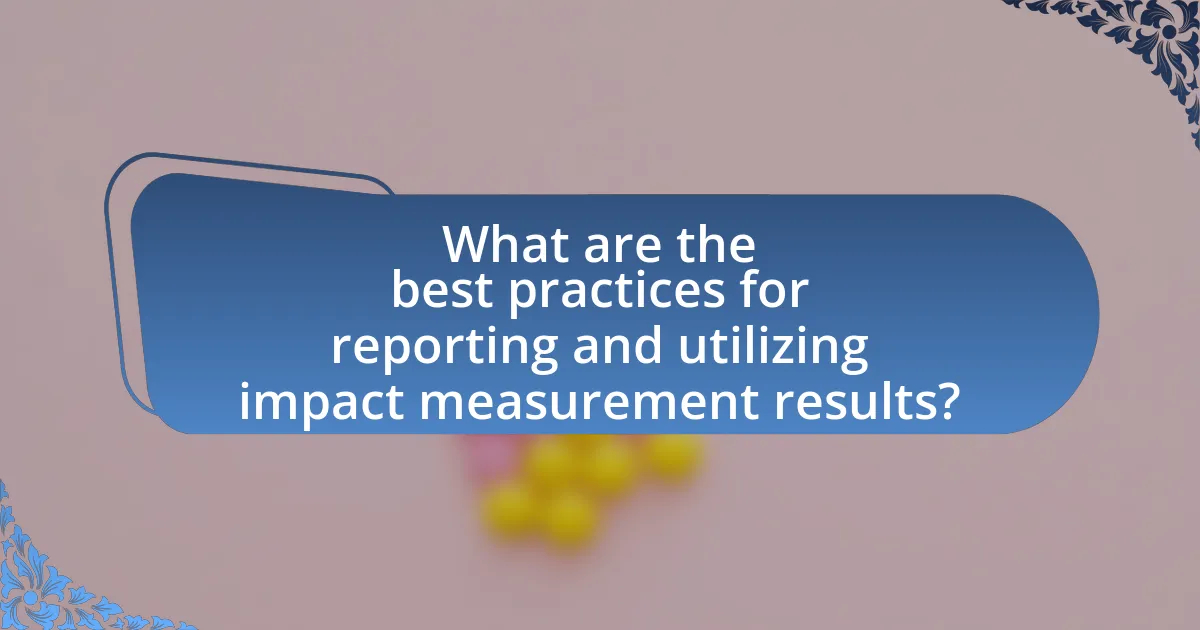
What are the best practices for reporting and utilizing impact measurement results?
The best practices for reporting and utilizing impact measurement results include clear communication of findings, stakeholder engagement, and actionable recommendations. Clear communication ensures that results are presented in an understandable format, such as visual aids or summaries, which enhances comprehension among diverse audiences. Engaging stakeholders, including community members and policymakers, fosters collaboration and ensures that the results are relevant and actionable. Actionable recommendations derived from the findings guide future program improvements and strategic planning. For instance, a study by the World Health Organization emphasizes that effective reporting should include both quantitative and qualitative data to provide a comprehensive view of impact, thereby supporting informed decision-making in oral health advocacy programs.
How should findings be communicated to stakeholders?
Findings should be communicated to stakeholders through clear, concise reports and presentations that highlight key data and actionable insights. Effective communication involves using visual aids such as graphs and charts to illustrate trends and outcomes, ensuring that complex information is easily digestible. For instance, a study published in the Journal of Public Health Management and Practice emphasizes the importance of tailoring communication to the audience’s level of understanding and interest, which enhances engagement and facilitates informed decision-making. Additionally, regular updates and feedback sessions can foster ongoing dialogue, allowing stakeholders to ask questions and provide input, thereby strengthening the relationship and commitment to the advocacy program.
What formats are most effective for presenting evaluation results?
The most effective formats for presenting evaluation results include visual presentations, written reports, and interactive dashboards. Visual presentations, such as slideshows or infographics, enhance understanding by simplifying complex data and making it more engaging. Written reports provide detailed insights and context, allowing for comprehensive analysis and documentation of findings. Interactive dashboards enable stakeholders to explore data dynamically, facilitating real-time analysis and decision-making. These formats are supported by research indicating that visual and interactive elements significantly improve information retention and comprehension among diverse audiences.
How can we ensure transparency in reporting outcomes?
To ensure transparency in reporting outcomes, organizations should adopt standardized reporting frameworks that provide clear guidelines on data collection, analysis, and presentation. Utilizing frameworks such as the Consolidated Standards of Reporting Trials (CONSORT) or the Transparent Reporting of Evaluations with Nonrandomized Designs (TREND) can enhance clarity and consistency in reporting. These frameworks promote the inclusion of essential information, such as study design, participant demographics, and outcome measures, which allows stakeholders to assess the validity and reliability of reported results. Research indicates that adherence to such standards improves the credibility of findings and fosters trust among stakeholders, as evidenced by a systematic review published in the Journal of Clinical Epidemiology, which found that studies following reporting guidelines had higher quality ratings.
What actions can be taken based on evaluation results?
Actions that can be taken based on evaluation results include adjusting program strategies, reallocating resources, and enhancing stakeholder engagement. For instance, if evaluation results indicate low community participation, program managers can modify outreach efforts to better align with community needs. Additionally, reallocating resources may involve increasing funding for successful initiatives while reducing support for less effective ones. Enhancing stakeholder engagement can be achieved by sharing evaluation findings with community partners to foster collaboration and improve program effectiveness. These actions are supported by evidence showing that data-driven decision-making leads to improved outcomes in health advocacy programs.
How can programs adapt based on feedback and findings?
Programs can adapt based on feedback and findings by implementing iterative evaluation processes that incorporate stakeholder input and data analysis. This approach allows programs to identify strengths and weaknesses, enabling targeted adjustments to strategies and activities. For instance, the use of surveys and focus groups can provide qualitative insights, while quantitative data from performance metrics can highlight areas needing improvement. Research shows that programs that regularly integrate feedback mechanisms, such as the Community-Based Participatory Research model, demonstrate increased effectiveness and community engagement, as evidenced by studies published in the Journal of Public Health Dentistry.
What strategies can be implemented for continuous improvement?
Strategies for continuous improvement in oral health advocacy programs include implementing regular feedback mechanisms, utilizing data analytics for performance measurement, and fostering a culture of collaboration among stakeholders. Regular feedback mechanisms, such as surveys and focus groups, allow organizations to gather insights from participants and adjust programs accordingly. Data analytics can identify trends and areas needing enhancement, ensuring that resources are allocated effectively. Additionally, fostering collaboration among stakeholders, including healthcare providers and community organizations, encourages the sharing of best practices and innovative solutions, which can lead to improved outcomes. These strategies are supported by evidence showing that organizations that actively seek feedback and utilize data-driven decision-making achieve higher levels of program effectiveness and participant satisfaction.
What practical tips can enhance the measurement of oral health advocacy program impact?
To enhance the measurement of oral health advocacy program impact, implement a combination of quantitative and qualitative metrics. Quantitative metrics can include tracking changes in oral health outcomes, such as the reduction in dental caries rates or increased access to dental care services, which can be validated through health department statistics. Qualitative metrics should involve gathering feedback from participants through surveys or interviews to assess changes in knowledge, attitudes, and behaviors regarding oral health. Additionally, establishing clear, measurable objectives at the program’s outset allows for more effective evaluation of outcomes against these benchmarks. Utilizing pre- and post-program assessments can provide concrete evidence of impact, as demonstrated in studies that show improved oral health literacy correlating with advocacy efforts.
